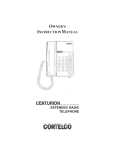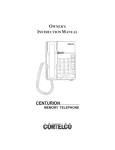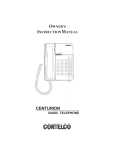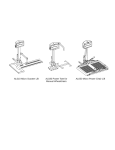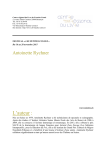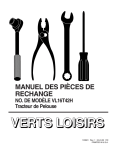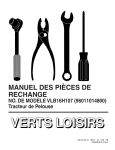Download Frigidaire 134969400A User's Manual
Transcript
CAUTION: TO SERVICE MACHINE, POWER MUST BE DISCONNECTED! DRYER TROUBLESHOOTING PROBLEM Motor runs but drum does not operate Broken or loose belt Loose motor, idler pulley, or spring Drum operates Drum out of shape Worn idler pulley but is noisy Belt squeaking or frayed Motor (bearing), motor pulley loose, blower Drum seals worn Motor will not stop CAUTION THIS MACHINE MUST BE ELECTRICALLY GROUNDED WHAT TO LOOK FOR It can be grounded thru the ground lead in the 4prong power cord, if plugged into a properly grounded appliance outlet or thru a separate No. 12 or larger wire from the cabinet to an established ground. In all cases, the grounding method must comply with any local electrical code requirements. IMPORTANT - RECONNECT ALL GROUNDING DEVICES Incorrect wiring Grounded motor or wiring Grounded heat element Faulty timer Open timer resistor Motor does not Blown fuse Timer or motor inoperative start Housing wiring not properly connected to dryer Inoperative door switch Faulty “Push to Start” switch Blocked or plugged lint collector, Slow dryingimproper drying blower housing or vent pipe Vent pipe too long Clothes too wet when put in dryer Dryer is overloaded Drum set is worn or out of position Door gasket not sealing correctly Control or safety thermostats inoperative House voltage fluctuating or low Customer selected wrong timer Clothes not drying on auto- setting Inoperative resistor dry setting Inoperative control thermostat Inoperative heating element Drum turns but Inoperative heating element heat does not Inoperative timer Loose terminals-tighten come on connections Inoperative control or safety thermostat Inoperative motor switch Broken wire in wiring harness Element burns Worn drum seals. Replace Connections not tight at element out frequently terminals Reduced air flow. Check for proper installation & maintenance of duct work. (See Installation Instructions) ALL PARTS OF THIS APPLIANCE CAPABLE OF CONDUCTING ELECTRICAL CURRENT ARE GROUNDED. IF GROUNDING WIRES, SCREWS, STRAPS, NUTS OR WASHERS USED TO COMPLETE A PATH TO GROUND ARE REMOVED FOR SERVICE, THEY MUST BE RETURNED TO THEIR ORIGINAL POSITION AND PROPERLY FASTENED. OPERATION - DRYER On electric model dryers, air is drawn into the heater housing and across the open coils of the electric heater. On gas model dryers, air is drawn into the combustion chamber and over the burner flame. It then is drawn through the tumbling clothes, picking up moisture and lint. Lint is filtered out as the air passes from the drum into the blower where it is discharged out the vent. The air temperature is controlled by the biased thermostat according to the setting of the fabric selector switch. The length of the drying cycle is controlled by the number of minutes selected on the timer, or automatically controlled by the timer, in conjunction with the electronic moisture sensor, for the type of fabric selected (automatic dry cycle). To operate the dryer, first check the lint screen and be certain that the screen is completely free of all lint. Place clothes in dryer and close door. (Dryer will not operate unless door is closed.) 1. 2. 3. Select the drying time, or automatic drying cycle, by turning timer knob to the right. Set drying temperature using timer for the type of fabric being dried. To start the dryer, turn the start knob to the right and hold for 2 seconds. DRUM SPEED 48-54 RPM in a counterclockwise direction as viewed from the front. RESISTORS HI-LIMIT THERMOSTAT IGNITOR The resistor, located in the thermostat heater circuit, causes the thermostat heater to generate varying amounts of heat. Resistors are connected to the timer or selector switches. Refer to the applicable wiring diagram. The hi-limit thermostat, single-pole, single throw switch wired in series with the control thermostat and heat source, is mounted to the top of the heater housing. Should the control thermostat fail or an air blockage occur, raising the heater housing temperature to 260° F. on electric or 240° F. on gas.,the hi-limit thermostat opens the circuit to the heat source and allows the heater housing to cool down to 190° F. To check the thermostat, remove drum. To check for stuck contacts in the thermostat, start the dryer and run on HIGH heat with the exhaust duct completely blocked. The hi-limit thermostat MUST open within three minutes. To check for an open thermostat, remove the harness wires from the thermostat terminals. Test for continuity. You should have continuity through a good thermostat at room temperature. The ignitor is a silicon thermistor. When it attains approximately 1800 F, the sensor (mounted on the side of the burner tube) detectes this high radiant heat and opens its contacts. This energizes the secondary solenoid valve coil, allowing gas to flow through the gas valve orifice and impinge upon the hot glowing ignitor. The total sequence occurs within 15 to 90 seconds. The igniter is mounted to the burner at an angle with the silicon carbide stem extended into the flame area. The stem is very fragile and susceptible to contamination from skin oils. HANDLE WITH CARE by using the ignitor's insulated support. Resistors are checked with an ohm meter and resistor values are marked on the schematic wiring diagram. A bad resistor will give improper drying temperatures. CONTROL THERMOSTAT The thermostat and bias heater are located on the blower housing. CHECKING THE CONTROL THERMOSTAT Remove harness wires from the thermostat. Determine the interior wiring by referring to the wiring diagram. Use an ohm meter to check the thermostats. 1. 2. 3. 4. Remove the exhaust venting from the rear of dryer. Place a thermometer (pocket type reading at least 300° F.) in rear of exhaust pipe. If dryer is installed between cabinets, making rear access difficult, the temperature can be checked by placing a thermocouple in the lint trap opening. Thermocouple shall be located one inch to the right of lint screen opening center line and extend three inches below the top of opening. Set timer for 30 minutes, or long enough to permit cycling of thermostat. Allow thermostat to cycle 3 or 4 times. Check temperature immediately after the third or fourth cycle of thermostat. The temperatures (depending on the temperature setting) should conform to those listed in the Temperature Chart. - AT EXHAUST DUCT OR LINT TRAP - NO LOAD TRIP TEMP SETTING HIGH MEDIUM LOW 145-190° F. 2-10° F. lower than high heat 2-10° F. lower than medium heat NOTE: LONG EXTENDED VENTS AFFECT DRUM TEMPERATURES. SAFETY THERMOSTAT The safety thermostat is wired in series with the motor for ELECTRIC MODELS and the burner for GAS MODELS. The purpose of the safety thermostat is to shut down the dryer if the control thermostat and hilimit thermostat fail to open. Once the safety thermostat has opened, it must be replaced. The condition that caused it to open must be corrected. HEATER ASSEMBLY (ELECTRIC ONLY) The heater assembly (208/240 volts) is located behind the drum. Perforations in the drum back allow heated air to be drawn into the drum. The heater is an open coil type heater made from a continuous coil of resistance wire attached to a metal support plate with ceramic stand offs. Heater Assembly Testing: 1. Disconnect Laundry Center from electrical supply. 2. Remove drum. 3. Remove leads to the heater element. 4. Connect ohmmeter across heater element terminals. 5. Check each terminal to ground. 6. If open or grounded, replace heater element. To 1. 2. 3. Remove or Replace Heating Element: Disconnect Laundry Center from electrical supply. Remove drum. Disconnect wires from safety thermostat, hi-limit thermostat, and ceramic insulator. 4. Remove four screws securing heating element assembly to rear panel and remove assembly. 5. Install new heating element. 6. Reverse procedure to reassemble. To 1. 2. 3. test the ignitor: Disconnect Laundry Center from electrical supply. Remove the dryer access panel and safety cover. Disconnect plug connector from ignitor-to-coil harness. 4. Check resistance value of ignitor. It should be approximately 50 to 800 Ohms depending on the room temperature. To 1. 2. 3. 4. replace ignitor: Disconnect Laundry Center from electrical supply. Remove burner assembly. Remove burner tube from burner assembly. Remove the 1/4" hex head screw and washer securing ignitor to its mounting bracket. 5. Reverse procedure to reinstall. DOOR SWITCH Whenever the door is opened, the door switch will open the circuit to the motor and the external switch in the motor will open the circuit to the heat source. CHECKING THE MOTOR The drive motor is 1/4 H.P., 1725 RPM with automatic reset overload protector. 1. Disconnect electrical current and remove ventilation panel. Remove harness wires from motor. 2. Operate motor by connecting a properly fused service cord to terminals 4 and 5. The motor should start and run. 3. If motor runs, problem is open circuits in the dryer electrical or control system. If motor does not run, check the centrifugal switch. 4. When motor runs and the problem is NO HEAT, check continuity between terminals 1 and 2 with the switch button out (run position). No continuity shows the switch is inoperative. Replace motor. DRYER DRIVE BELT To 1. 2. 3. 4. 5. 6. Remove or Replace Dryer Drive Belt: Disconnect Laundry Center from electrical supply. Remove front panel and air duct assembly. Disconnect belt from idler pulley and motor pulley. Remove belt from dryer drum. Install new belt. Reverse procedure to reassemble. PART NO. 134969400A Mauvaise sélection de cycle par le client Résistance défectueuse Thermostat de contrôle défectueux Elément chauffant défectueux Le tambour tourne mais l’élément chauffant ne fonctionne pas Element chauffant défectueux Minuterie défectueuse Bornes desserrées - resserrer les connexions Thermostat de contrôle ou de sécurité défectueux Interrupteur de moteur défectueux Fils coupés dans le faisceau Joints de tambour usés. Les remplacer. Connexions desserrées aux L’élément brûle bornes de l’élément fréquemment Circulation d’air réduite. Vérifier l’installation et l’entretien des conduits. (Voir Instructions d’installation) Le cycle de séchage automatique ne sèche pas les vêtements Filtre à charpie, boîtier de ventilateur ou tuyau d’évacuation d’air obstrué ou bloqué Tuyau d’évacuation d’air trop long Chargement de vêtements ou linge trop mouillé Surcharge de la sécheuse L’ensemble de tambour est usé ou désaligné Mauvaise étanchéité du joint de porte Thermostat de contrôle ou de sécurité défectueux Tension d’alimentation fluctuante ou faible Le moteur ne démarre pas Séchage lent ou incomplet Fusible grillé Moteur ou minuterie défectueux Branchement incorrect au câblage de la maison Interrupteur de porte défectueux Bouton-poussoir de démarrage défectueux Le moteur ne s’arrête pas Tambour déformé Poulie folle usée Courroie qui couine or effilochée Moteur (roulement), poulie motrice desserrée, ventilateur Joints de tambour usés Moteur, poulie folle, ou ressort mal fixé. Courroie brisée ou détendue Branchement incorrect des câbles Moteur ou câblage à la terre Élément chauffant à la terre Minuterie défectueuse Résistance de minuterie infinie Le tambour fonctionne mais bruyamment Le moteur fonctionne mais le tambour ne fonctionne pas DÉPANNAGE SÉCHEUSE VÉRIFIER PROBLÈME RÉSISTANCES 48-54 RPM dans le sens inverse des aiguilles d’une montre, vu de l’avant. VITESSE DE ROTATION DU TAMBOUR Le thermostat anti-surchauffe, unipolaire, à interrupteur unipolaire (voir SPST) branché en série avec le thermostat de contrôle et la source de chaleur est fixé à la partie supérieure du boîtier du réchauffeur. En cas de défectuosité du thermostat de contrôle ou de blocage de l’évacuation d’air causant une augmentation de température du boîtier du réchauffeur à 260 degrés F. ou 240 degrés sur le gaz, le thermostat anti-surchauffe coupe le circuit vers la source de chaleur, permettant ainsi au boîtier du réchauffeur de se refroidir à 190 degré F. Pour vérifier le thermostat, démonter le tambour. Pour vérifier le blocage éventuel des contacts du thermostat, démarrer la sécheuse et la faire fonctionner à température maximum (High) tout en bloquant complètement le tuyau d’évacuation d’air. Le thermostat anti-surchauffe doit entrer en action dans les trois minutes. Pour vérifier que le thermostat est normalement fermé, démonter le faisceau de fils des bornes du thermostat. Tester la continuité qui doit normalement exister à la température ambiante dans thermostat en bon état. THERMOSTAT ANTI-SURCHAUFFE 1. Retirer l’orifice d’évacuation à l’arrière de la sécheuse. Placer un thermomètre (de poche montant au moins à 300 degrés F) à l’arrière du tuyau d’évacuation. L’INTÉRIEUR DU TAMBOUR. Vérification de l’élément chauffant: 1. Débrancher l’alimentation électrique du combiné laveuse/sécheuse. 2. Démonter le tambour. 3. Demonter les connexions de l’élément chauffant. 4. Mesurer la résistance entre les deux bornes de l’élément chauffant. 5. Vérifier la résistance de chaque borne par rapport à la terre. 6. Si l’élément est coupé ou mis à la terre, le remplacer. Pour démonter ou remplacer l’élément chauffant 1. Débrancher l’alimentation électrique du combiné laveuse/sécheuse. 2. Demonter le tambour. 3. Débrancher les fils du thermostat de sécurité, du thermostat anti-surchauffe et des isolateurs céramique. 4. Démonter les quatre vis fixant l’ensemble de l’élément chauffant au panneau arrière et le déposer. 5. Installer le nouvel élément chauffant. 6. Pour le remontage, procéder en sens inverse. L’ensemble de réchauffeur (208/240 volts) se trouve derrière le tambour. Des perforations à l’arrière du tambour permettent à l’air réchauffé de pénétrer dans le tambour. Le réchauffeur est du type résistance hélicoidale bipolaire à filament continu fixé sur une plaque de montage en métal à l’aide d’isolateurs en céramique. ENSEMBLE DE RÉCHAUFFEUR (ElectrqueSeulement) Le thermostat de sécurité est câblé en série avec le moteur pour APPAREILS ÉLECTRIQUES et avec le brûleur pour MODÈLES AU GAZ. Il a pour rôle d’arrêter la sécheuse si le thermostat de contrôle et le thermostat anti-surchauffe ne coupent pas le circuit. Le thermostat de sécurité doit être remplacé après chaque activation. Il faut remédier à la situation qui a causé son déclenchement. Démonter le faisceau de fils du thermostat. Déterminer les connexions d’après schéma de câblage. Utiliser un ohmmètre pour vérifier le thermostat. THERMOSTAT DE SÉCURITÉ VÉRIFICATION DU THERMOSTAT DE CONTRÔLE Le thermostat et réchauffeur de polarisation sont situés sur le boîtier du ventilateur. THERMOSTAT DE CONTRÔLE L’air aspiré dans le boîtier du réchauffeur circule autour Si la sécheuse est encastrée et rend l’accès par des éléments du chauffage électrique. Sur des l’arrière difficile, il est possible de vérifier la dessiccateurs de modèle de gaz, de l'air est dessiné température en plaçant un thermocouple dans dans la chambre de combustion et l'excédent la l’ouverture du filtre à charpie. Placer celui-ci un flamme de brûleue L’air réchauffé passe ensuite dans pouce à droite du centre de l’ouverture, et à trois le tambour contenant les vêtements, et en retire pouces du bors supérieur. l’humidité et la charpie. Cette dernière est filtrée lorsque 2. Régler la minuterie à 30 minutes ou une durée l’air passe du tambour au ventilateur qui rejette l’air par permettant au thermostat d’entrer en action. l’orifice d’évacuation. La température de l’air est 3. S’assurer que le thermostat fait 3 ou 4 cycles. contrôlée par un thermostat actionné par le réglage du 4. Vérifier la température immédiatement après le sélecteur de type de tissu. La durée du cycle de troisième ou quatrième cycle du thermostat. Les séchage est fonction du nombre de minutes températures (selon le réglage de température) sélectionnées par réglage manuel de la minuterie ou doivent correspondre à celles qui figurent au tabest automatiquement contrôlée conjointement par la leau des températures. minuterie et le sonde électronique d'humidité en fonction de la sélection du type de tissu (cycle de séchage - A L’ORIFICE D’ÉVACUATION OU FILTRE À automatique). CHARPIE - SANS CHARGE Pour faire fonctionner la sécheuse, vérifier d’abord que le filtre à charpie n’est recouvert d’aucune charpie. Placer les vêtements dans la sécheuse et fermer la TEMPÉRATURE D’ENCLENCHEMENT porte. (La sécheuse ne fonctionne pas la porte ouverte.) RÉGLAGE HAUT (HIGH) 145 - 190 degrés F 1. Sélectionner la durée de séchage désirée ou le cycle MOYEN (MEDIUM) 2 - 10 degrés F plus bas de séchage automatique en tournant le bouton de que Haut la minuterie vers la droite. BAS (LOW) 2 - 10 degrés F plus bas 2. Régler le sélecteur de type de tissu en fonction du que moyen type de tissu à sécher. 3. Démarrer la sécheuse en appuyant durant 2 NOTA: LA LONGUEUR DES CONDUITS secondes sur le bouton de démarrage. D’ÉVACUATION AFFECTE LA TEMPÉRATURE À DESCRIPTION DU FONCTIONNEMENT TOUTES LES PIÈCES DE CET APPAREIL CONDUCTRICES DE L’ÉLECTRICITÉ SONT MISES À LA TERRE. SI POUR L’ENTRETIEN OU LA RÉPARATION IL EST NÉCESSAIRE DE DÉMONTER DES FILS, CÂBLES, VIS, TRESSES, BOULONS OU RONDELLES SERVANT À ASSURER LA CONTINUITÉ DU CIRCUIT DE MISE À LA TERRE, CEUX-CI DOIVENT ÊTRE REMONTÉS À LEUR EMPLACEMENT INITIAL ET SERRÉS CORRECTEMENT. IMPORTANT - REBRANCHER TOUS LES DISPOSITIFS DE MISE À LA TERRE La résistance présente dans le circuit du thermostat du réchauffeur module le niveau de chaleur. Les résistances sont branchées à la minuterie et aux Il peut être mis à la terre à l’aide du fil de terre du sélecteurs. Voir le schéma de câblage approprié. cordon d’alimentation à quatre bornes lors du branchement à une prise pour appareil électrique On contrôle les résistances à l’aide d’un ohmmètre elle-même correctement mise à la terre, ou à et le schéma de câblage fournit indique leur valeur. l’aide d’un fil No.12 ou de calibre supérieur reli- Une résistance défectueuse produit un écart dans la ant la carosserie à une prise de terre. Dans tous températures de séchage. les cas la connexion doit respecter toutes les exigences des codes d’électricité locaux. AVERTISSEMENT CET APPAREIL DOIT ÊTRE MIS À LA TERRE N/P134969400A COURROIE D’ENTRAÎNEMENT DE LA SÉCHEUSE Pour démonter ou remplacer la courroie d’entraînement de la sécheuse : 1. Débrancher l’alimentation électrique du combiné laveuse/sécheuse. 2. Démonter le panneau avant et l’ensemble des conduits de ventilation. 3. Sortir la courroie de la poulie folle et de la poulie motrice. 4. Sortir la courroie du tambour de la sécheuse. 5. Installer la nouvelle courroie. 6. Pour le remontage, procéder en sens inverse. VÉRIFICATION DU MOTEUR Moteur de 1/4 C.V., 1725 T/M, muni d’un interrupteur de surcharge à réenclenchement automatique. 1. Débrancher l’alimentation et démonter le panneau de ventilation. Démonter le faisceau de fils du moteur. 2. Faire fonctionner le moteur en branchant un cordon d’alimentation de réparation muni d’un fusible aux bornes 4 et 5. Le moteur doit démarrer et tourner. 3. Si le moteur fonctionne, le problème est relié à des circuits défectueux dans le circuit électrique de la sécheuse ou dans le circuit du système de commande. Si le moteur ne fonctionne pas, vérifier l’interrupteur centrifuge. 4 Si le moteur tourne et qu’il n’y a pas de chauffage, vérifier la continuité entre les bornes 1 et 2 avec le bouton-poussoir de l’interrupteur tiré (position de fonctionnement). L’absence de continuité indique une défectuosité de l’interrupteur. Remplacer le moteur. INTERRUPTEUR DE PORTE Lorsque la porte est ouverte, l’interrupteur de porte coupe le circuit au moteur et l’interrupteur extérieur du moteur coupe le circuit vers la source de chauffage. L'ignitor est une thermistance de silicium. Quand il atteint approximativement 1800 degrés de F., sensor (mounted du côté des tube) detects de brûleur la chaleur radiante élevée et ouvre ses contacts. Cesi active l'enroulement secondaire de valve de solénoïde, permettant au gaz de traverser l'orifice de clapet à gaz et d'empiéter sur l'ignitor rougeoyant chaud. Toute le ordre se produit dans 15 à 90 secondes. L'ignitor est monté au brûleur à un angle de tige de carbure de silicium avancée au secteur de flamme. La tige est très fragile et susceptible de la contamination à partir des sécrétions cutanées. Manipulez avec soin en utilisant l'appui isolé des ignitor. Pour examiner l'ignitor: 1. Démontez le centre de blanchisserie de l'alimentation électrique. 2. Enlevez le panneau d'access de dessiccateur et la couverture de sûreté. 3. Débranchez le connecteur de prise de ignitor-à-lovent le harnais. 4. Vérifiez la valeur de résistance de l'ignitor. Ce devrait être approximativement 50 à 800 ohms selon la température ambiante. Pour remplacer l'ignitor: 1. Démontez le centre de blanchisserie de l'alimentation électrique. 2. Enlevez le brûleur. 3. Enlevez le tube de brûleur du brûleur. 4. Enlevez la vis à tête hex 1/4" et la rondelle fixant l'ignitor à son support. 5. Procédé renversé à réinstaller. IGNITOR AVERTISSEMENT: DÉBRANCHER L'ALIMENTATION AVANT DE PROCÉDER À L'ENTRETIEN DE CET APPAREIL!
This document in other languages
- français: Frigidaire 134969400A








